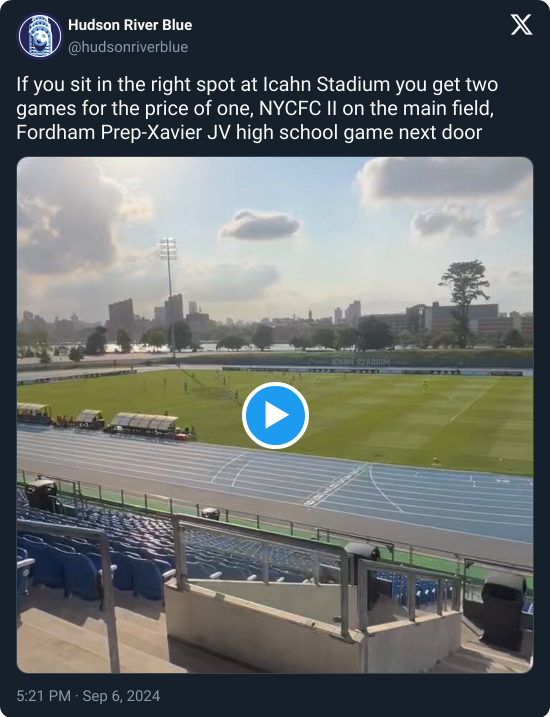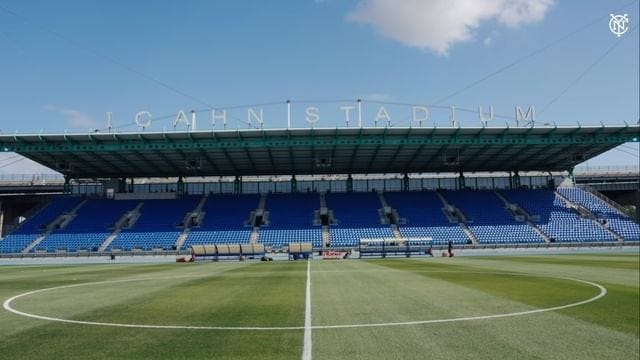Icahn Dream: COO Jennifer O’Sullivan on NYCFC II’s New Stadium
NYCFC COO Jen O'Sullivan sat down to discuss Icahn Stadium, how it could be used by the first-team & Man City, the future of the IIs, and how the club is exploring a move to a new training facility.
Editor’s Note: New York City FC Chief Operating Officer Jennifer O’Sullivan sat with The Outfield’s Justin Egan & Alec Kossof, Hudson River Blue’s Oliver Strand, and Spanish Radio play-by-play announcer Roberto Abramowitz at halftime of New York City FC II’s first match at Icahn Stadium on September 6th. This interview has been edited for clarity and length.
How did New York City FC II at Icahn Stadium come about?
Jennifer O’Sullivan: The DNA of this club is about growing the game, and growing the game in the city. We recognized a long time ago, this was an iconic venue. [Randall’s Island] is a park that is dedicated to community and dedicated to so much soccer. There was this crazy idea of how we could potentially make this into a proper soccer pitch, to have this venue be utilized for professional soccer. We've got kids that are here. How can we bring the pro game to them and make it closer to them? We have relationships with [Randall's Island Park Alliance (RIPA)] and folks here and have the conversation and said, ‘Is this something you're open to?’ and they were. They were amendable to it. It was a lot of work and a lot of dedication for a lot of people on both sides, but I think everyone believed in the vision to bring the professional game to this venue.
To have the backdrop of Manhattan to be touching on Queens and the Bronx. It's a very unique location. It helps to celebrate the city and the possibility that this venue brings for soccer.
Icahn Stadium was built in a way that wouldn’t allow for any soccer. It was part of the DNA of the venue that it was only going to be for track and field. How did that change?
JO: The Icahn name and the venue itself are so well known, in the track and field space, but at the very heart of this entire place, its community. It's bringing people together and celebrating sports and athletics.
So, we had a conversation [about how] soccer is growing in this country, is growing in the city, and it's the future. It's a sport that brings together so many in this community. There is a way for track and field and for soccer to live side by side here and to expose something like [Icahn Stadium] to the potential of what soccer can be. [RIPA] were incredibly amenable to it. It was sort of an easy conversation to sell that vision to the folks here.
New York City FC II has two games here this year. What's the vision for next year?
JO: [New York City FC has had] great partners in St. John's University where we've been with our NYCFC II and our academy. There's a challenge here with track and field because that is their primary during the beginning NYCFC II season. So I think there are some conversations we’ve had about how we could expand, what's the ability to play more games here?
We're very open to what that looks like. Would there be potential for US Open Cup games? Could there be potential for other first-team matches that are here? It's something that is truly unique. You all know that there are just not many grass pitches in this city to be able to capitalize on.
I think that there's even greater potential here, if you look at Field 10, if you look at the sort of environment that can be created, there's a lot that can be here. We're open to discussing what that looks like for the future.
There were rumors about this plan for the last couple of years. Was there anything specific that pushed this over the line?
JO: If you think about the priorities that NYCFC has had when it comes to infrastructure and facilities…our own stadium has always been the first priority and that being the first domino that needed to fall, seeing that [the Willet’s Point Stadium] is on a path to positive happening has allowed us to be able to turn our attention to other things in the business. Then to be able to say we can actually make this happen, this would be the next domino to fall, and have our NYCFC II team have an opportunity to play on grass. Give those guys that development, opportunity, and potentially academy games. Are there other things that [NCYFC] can do here focusing on the professional use of this campus pitch? I think it was knowing that our own home in the stadium is really on the path to positivity to then be able to turn our attention to something like [Icahn Stadium].
New York City FC made a large capital investment in modernizing Icahn Stadium, especially the grass. Who is responsible for maintaining the field?
JO: That falls under RIPA. It’s new for them, but we are working with them to provide guidance and assistance to them talking about what the standards are for the upkeep of the field and how to do that. I think they've been great and they've obviously done a great job getting it ready to this point.
When we talk about [Manchester City and other European clubs] coming to [New York City], there's now an opportunity for other [professional] teams to come train here for matches, and to use this place.
Giving [RIPA] the standards that are set in our organization at [City Football Group] and the learnings that we have had [about pitch maintenance] is something that we're happy to share with them to make sure that this pitch is going to be available and ready for us.
With New York City FC II not playing at the new stadium, is there an opportunity for them to be a globetrotting team within the five boroughs?
JO: I don’t think so. [New York City FC] has been nomads for a long time, right? There's something to be said about having your own home base and your own home stadium. It is an incredible amount of work from our operations team and for a lot of our other departments to put on games at different facilities. The idea is to really be able to turn our attention to the NYCFC II team and that brand... What is the best location for them to play to succeed, to build a fan base around them, to build a brand around them, to allow them to have a home that is permanently theirs.
We're not there yet with them, but we're starting those conversations. It's more about finding a place for them versus multiple places for them.
Which may not necessarily be in New York City.
JO: It may not, but the feeling right now is that [Icahn Stadium] is a great starter for them
You have a strong relationship with the Department of Parks and Recreation seems to be unique amongst professional teams in New York City. You had the Parks kit last year. Can you speak about this relationship and if there is anything else coming down the pipeline?
JO: You're right. We do have a great relationship with them. A lot of that has been based on our community work and the 50 mini-pitches that we built. There's been a lot of work over the years that has been done.
Now the conversation has started about the 26 pitches we’ve committed to building before the World Cup in [2026]. The only other thing I would say is that when you talk about the work we do in the community, you talk about how to reach kids, how to reach and grow the game of soccer- the Parks Department is a natural ally for us to have with the reach that they have in the five boroughs in the city.
[Flushing Meadows Corona Park] is going to be in our backyard. We're really, really proud that we are going to be the main honoree for their gala later this month. We're continuing to build those relationships with the Parks Department and others to see what else is possible out there for us to continue to grow the game.
As New York City FC gets closer to the new stadium at Willets Point have there been talks about shifting some of the club infrastructure closer to Queens?
JO: The club headquarters will be in the stadium. [City in the Community’s] headquarters will be in the stadium. But there are no other conversations around the training facility or anything yet.
We've been exploring other sites to potentially expand or grow. Find a new site for our training facility because we've got the NYCFC2 team. We’ve said before that we'd love to have a women's team someday. [The] perfect vision would be to have one campus for everybody. It's a challenge to do that in the city, but we're having a lot of conversations around the area to see what [is possible].
That's a longer-term longer-range plan for us, but it's one that having the stadium fall is the first domino. [That] allows us to turn to other areas and that's one of the areas that we'll be looking at for sure. ❧
Image: New York City Department of Parks and Recreation, Downing Stadium during the 1964 U.S. Olympic track and field trials








